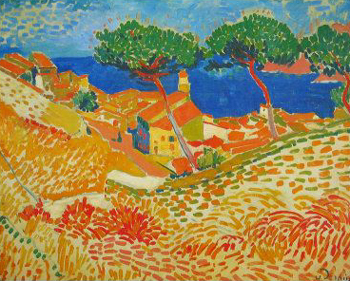
Colliourealso known as Vue de Collioure

|
Collioure (Vue de Collioure)
“We were always intoxicated with color, with words that speak of color, and with the sun that makes colors live.”- Andre Derain
Andre Derain was most celebrated for his use of bold, bright colors and his remarkable ability to create dramatic light in his artwork; his painting titled ‘Collioure’ or ‘Vue de Collioure’ embodies his unique style.
Analysis
Andre Derain’s application of pure, unadulterated color in ‘Collioure’ offers an amplified expression of fauvism, especially obvious in the artist’s use of bright light throughout the painting. The deep red foliage in the foreground creates a powerful and significant contrast with the intense blue hue of the lake in the background.
Derain’s use of broad and prominent brushstrokes not only brings ‘Collioure’ to life, but also suggests his passion and fondness for the small village. The technique is distinctive, stylish, and important as it brings wonderful texture to the composition. The scene invites the viewer to experience the hospitality and charm of ‘Collioure’, an area that has captivated many artists over the years.
History
After spending the summer of 1905 in Collioure, a quaint little fishing harbour in the south of France, with contemporary and good friend, Henri Matisse, Derain created a series of expression/fauvism art works. Together, the two artists generated an innovative approach to fauvism art, bringing a new sense of vitality to the expressionism genre. Eventually, they would be considered the leaders within a group of artists that art critic Louis Vauxcelles is credited with coining “Les Fauves” (The Wild Beasts).
‘Collioure’, as well as many of Derain’s other paintings from that time, was displayed alongside Matisse’s works at the Salon d'Automne in October of 1905, receiving shocking reviews with regard to the boldness and audacity of intense color use. This event is considered by many artists and critics to be the ultimate birth of fauvism.
‘Collioure’ is currently located at the Museum Folkwang in Essen, Germany.












